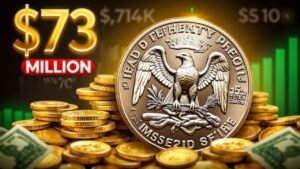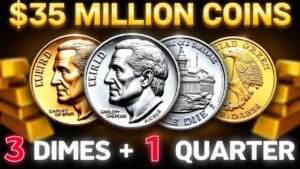Introduction
Few coins in the immortal world of collecting can compare with the 1976-S Silver-clad Bicentennial Quarterly. Released as a tribute to the 200th anniversary of U.S. independence, this commemorative piece occupies a singular place among coin lovers, as much for history buffs. With its unique design and limited coinage, this quarter has become a treasure hunt for those who appreciate historical significance and possible future value.
Cover story of the 1976-S Bicentennial Quarterly
The glory of the United States bicentennial-the mint issued these large half-dollars, half-dollar, and dollar pieces in 1975 and 1976. Unlike the regular tricentennial, the bicentennial has a distinct flip date of “1776-1 Construction and views by Jack L. Ahr.”
On the reverse is a portrait of a colonial drummer holding a lantern surrounded by 13 stars, symbolizing the original colonies. This arrangement replaced the conventional lobster and was a one-off bicentennial celebration, allowing these four locations to be instantly recognizable.
1976-S Silver-Clad Composition

While most of the bicentennials were produced in conventional copper-nickel plated construction, the silver-plated 1976-S bicentennial stands out. These four spaces were designed specifically for collectors and include:
- Composition: 40% silver; 60% copper.
- Mint mark: “S,” although it means they were minted in the San Francisco Mint
- Finishing: Available in proofs and unreleased versions
This makes these coins more attractive than their counterparts in copper and nickel: intrinsic silver value and appeal to numismatists
Rarity and Value of the 1976-S Silver-Clad Bicentennial Quarter
The rarity of the 1976-S Quarterly does not depend on its design. It depends, however, on the actual composition and condition of the coin. More than 15 million copies of the four silver-plated coins have been produced, but have only been sold as part of the Centennial coin series, which has never been released to the general public
Factors Influencing Value:
- Condition: Gold fetches higher prices in full size (PF70) or mint condition (MS70).
- Packaging: Original government packaging or set you can add to the price.
- Price of silver: The market price of silver can affect the base price of a currency.
The average silver-plated 1976-S bicentennial can be used for $5 to $20, while older proofs can sell for $30 or more Rare grading discrepancies or extraordinary savings can be provided a significant increase in price.
How to Identify the 1976-S Silver-Clad Quarter
If you think you might have a 1976-S Bicentennial Quarter, look for these identification marks:
- Check the Mint Mark: The obverse will have the mintmark “S” just above the date.
- Examine the Proof: Proof varieties will have a mirror-like luster, and non-circulated coins a satin-like glow.
- Check for Composition: The silver-coated quarters differ in color and weight from copper-nickel coins.

How to Take Care of Your 1976-S Bicentennial Quarter
Keeping safe is important for maintaining or appreciating the values of your Bicentennial Quarter:
- Handle Carefully: Always hold the coin by its edges to avoid smudges or fingerprints.
- Use Protective Holders: Store the coin in an airtight holder or a certified grading slab to protect it from moisture and dust.
- Do Not Clean: Coin cleaning can be detrimental to their surfaces and can devalue the coins. Stained coins are usually preferred in their natural condition.
- Control Environments: A coin should be housed in a permanent, dry environment with little temperature fluctuation.
Conclusion
The 1976-S Silver-plated Bicentennial Quarter is a hidden treasure that appeals to collectors and history buffs. This coin is unique in design, not limited in design, and in silver, typical of the mint industry. For the experienced collector or the curious, adding these commemorative coins to your collection provides a glimpse into the past and promises potential value future
FAQ’s
What is the value of the 1976-S bicentennial quarter under MS60 conditions?
In MS60 condition, these coins typically sell for $10 to $30, although higher coins can be worth more.
Can I have a bicentennial quarter used today?
It was widely distributed during the usual bicentennial, but the 1976-S silver-plated edition was included only in collection groups.
Do I need to wash my bicentennial to make it look good?
No, laundering money can damage its appearance and reduce its value. Collectors want coins in original condition.


